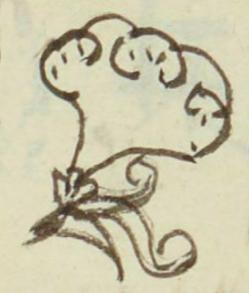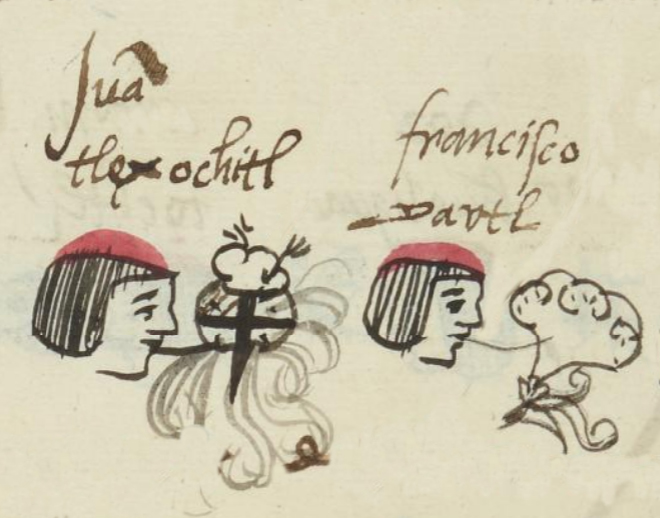Tlexochitl (MH503v)
This black-line drawing of the compound glyph for the personal name Tlexochitl ("Fire-Flower," attested here as a man’s name) shows a frontal view of a flower (xochitl) with at least three petals. At the tops of the petals are dots, perhaps suggesting fragrance. At the bottom of the flower is a stem and perhaps some leaves, along with the curling flames and smoke of fire (tletl) that curl to the right.
Stephanie Wood
Eduard Seler, in his study of Codex Vaticanus No. 3773 (Codex Vaticanus B), published in 1903, says that the tlepapalotl "is a synonym of the tlexochtli" (aka tlexochitl), p. 29. The tlepapalotl refers to a moth that flies into the fire at night, seeking light. Louise Burkhart (The Slippery Earth, 1989, 207) writes of the tlepapalotl as "the moth that flies into the fire and dies" and "was used in indigenous moral discourse to denote the angry person who seeks conflict with others."
As the contextualizing image shows, the name glyphs for two men listed in a row seem to have been reversed. The gloss for this glyph is given as "yautl," but there is nothing here to suggest combatant. The other man is supposed to be "tlexochitl" but his glyph does have the shield that suggests yaotl.
The theory that the dots at the top of the flower represent visual fragrance comes from the compound glyph for the place name Xochiacan (on folio 10 verso of the Codex Mendoza), below, where the dots emerge from the flower to enter the nose of the sniffer.
Stephanie Wood
Juā
tlexochitl
Juan Tlexochitl
Stephanie Wood
1560
Jeff Haskett-Wood
flowers, flores, fire, fuego, fragrance, fragancia, perfume

tle(tl), flame, fire, https://nahuatl.wired-humanities.org/content/tletl
xochi(tl), flower, https://nahuatl.wired-humanities.org/content/xochitl
Matrícula de Huexotzinco, folio 503v, https://www.loc.gov/resource/gdcwdl.wdl_15282/?sp=86&st=image
This manuscript is hosted by the Library of Congress and the World Digital Library; used here with the Creative Commons, “Attribution-NonCommercial-ShareAlike 3.0 License” (CC-BY-NC-SAq 3.0).





